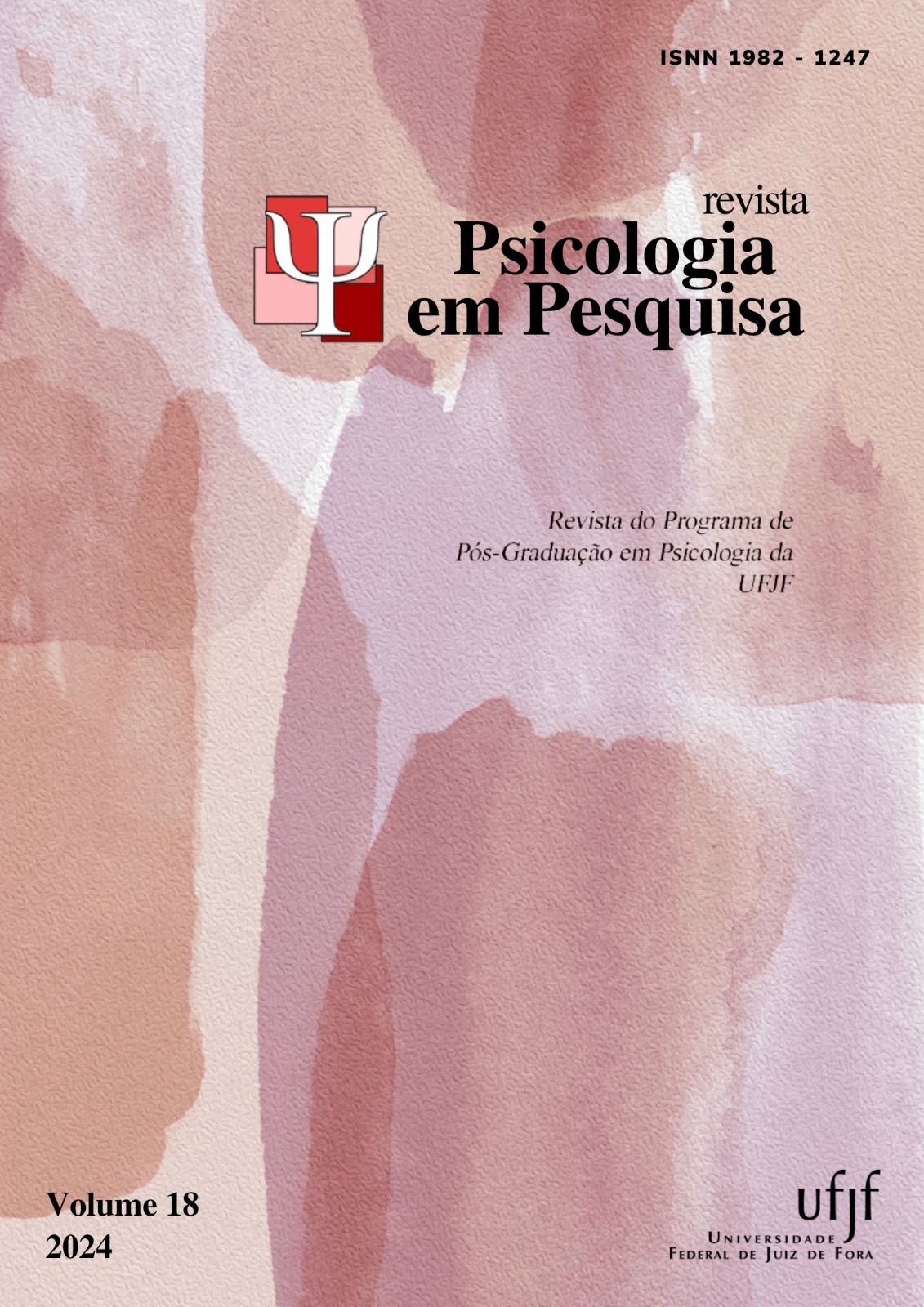Estatística das cores em obras de arte e a hipótese da naturalidade
DOI:
https://doi.org/10.34019/1982-1247.2024.v1.37753Palavras-chave:
visão de cor, estatística das cores, preferência estética, naturalidade, artes visuais, Color vision, Color statistics, Aesthetic preference, Naturalness, Visual arts, Visión del color, Estadísticas de los colores, Preferencia estética, Naturalidad, Artes visualesResumo
Avanços matemáticos permitiram análises estatísticas das características colorimétricas de
cenas visuais complexas, incluindo fotografias e pinturas. Resultados indicam que os
artistas utilizam composições similares com a dos ambientes naturais. Estudos
quantitativos de preferência estética para diferentes composições colorimétricas parecem
estar de acordo com a hipótese da codificação eficiente, que supõe uma relação entre
preferência e naturalidade. Esta revisão fornece subsídios sobre as teorias da visão de
cores, metodologias psicofísicas e métodos recentes de medida de cor, como as medidas
hiperespectrais, para futuros estudos que busquem analisar relações entre preferências e
composições cromáticas.
Downloads
Referências
Albers, A. M., Gegenfurtner, K. R., & Nascimento, S. M. (2020). An independent contribution of colour to the aesthetic preference for paintings. Vision Research, 177, 109–117. https://doi.org/10.1016/j.visres.2020.08.005
Artusi, A., Mantiuk, R. K., Richter, T., Hanhart, P., Korshunov, P., Agostinelli, M., Ten, A., & Ebrahimi, T. (2019). Overview and evaluation of the JPEG XT HDR image compression standard. Journal of Real-Time Image Processing, 16(2), 413–428. https://doi.org/10.1007/s11554-015-0547-x
Fairchild, M. D. (2013). Color appearance models (3rd ed.). Wiley.
Fairchild, M. D. (2019). CIE 015:2018 Colorimetry, 4th Edition. The International Commission on Illumination, Vienna, Austria, 2019. 111 pp. €162.00 Members of CIE country bodies pay €54.00; hardcover or e‐book. Color Research & Application, 44(4), 674–675. https://doi.org/10.1002/col.22387
Feitosa-Santana, C., Gaddi, C. M., Gomes, A. E., & Nascimento, S. M. C. (2020). Art through the colors of graffiti: From the perspective of the chromatic structure. Sensors, 20(9), 2531. https://doi.org/10.3390/s20092531
Feitosa-Santana, C., Oiwa, N. N., Costa, M. F. D., Tiedemann, K. B., Silveira, L. C. D. L., & Ventura, D. F. (2006). Espaço de cores. Psicologia USP, 17(4), 35–62. https://doi.org/10.1590/s0103-65642006000400003
Foster, D. H., & Amano, K. (2019). Hyperspectral imaging in color vision research: Tutorial. Journal of the Optical Society of America A, 36(4), 606. https://doi.org/10.1364/josaa.36.000606
Geisler, W. S. (2008). Visual perception and the statistical properties of natural scenes. Annual Review of Psychology, 59(1), 167–192. https://doi.org/10.1146/annurev.psych.58.110405.085632
Graham, D. J., & Redies, C. (2010). Statistical regularities in art: Relations with visual coding and perception. Vision Research, 50(16), 1503–1509. https://doi.org/10.1016/j.visres.2010.05.002
Kim, D., Son, S. W., & Jeong, H. (2014). Large-scale quantitative analysis of painting arts. Scientific Reports, 4(1), 1-7. https://doi.org/10.1038/srep07370
Linhares, J. M. M., Pinto, P. D., & Nascimento, S. M. C. (2008). The number of discernible colors in natural scenes. Journal of the Optical Society of America A, 25(12), 2918–2924. https://doi.org/10.1364/josaa.25.002918
Linhares, J., Cardeira, L., Bailão, A., Pastilha, R., & Nascimento, S. (2020). Chromatic changes in paintings of Adriano de Sousa Lopes after the removal of aged varnish. Conservar Património, 34, 50–64. https://doi.org/10.14568/cp2018064
Mallon, B., Redies, C., & Hayn-Leichsenring, G. U. (2014). Beauty in abstract paintings: Perceptual contrast and statistical properties. Frontiers in Human Neuroscience, 8(161), 1–14. https://doi.org/10.3389/fnhum.2014.00161
Montagner, C., Linhares, J. M. M., Vilarigues, M., & Nascimento, S. M. C. (2016). Statistics of colors in paintings and natural scenes. Journal of the Optical Society of America A, 33(3), A170. https://doi.org/10.1364/josaa.33.00a170
Montagner, C., Linhares, J. M., Vilarigues, M., Melo, M. J., & Nascimento, S. M. (2017). Supporting history of art with colorimetry: The paintings of Amadeo de Souza-Cardoso. Color Research & Application, 43(3), 304–310. https://doi.org/10.1002/col.22189
Nascimento, S. M. C., Herdeiro, C. F. M., Gomes, A. E., Linhares, J. M. M., Kondo, T., & Nakauchi, S. (2020). The best CCT for appreciation of paintings under daylight illuminants is different for occidental and oriental viewers. LEUKOS, 17(3), 310–318. https://doi.org/10.1080/15502724.2020.1761828
Nascimento, S. M., Linhares, J. M., Montagner, C., João, C. A., Amano, K., Alfaro, C., & Bailão, A. (2017). The colors of paintings and viewers’ preferences. Vision Research, 130, 76–84. https://doi.org/10.1016/j.visres.2016.11.006
Nascimento, S. M., Marit Albers, A., & Gegenfurtner, K. R. (2021). Naturalness and aesthetics of colors – Preference for color compositions perceived as natural. Vision Research, 185, 98–110. https://doi.org/10.1016/j.visres.2021.03.010
Ogawa, N., & Motoyoshi, I. (2020). Differential effects of orientation and spatial-frequency spectra on visual unpleasantness. Frontiers in Psychology, 11, e1342. https://doi.org/10.3389/fpsyg.2020.01342
Palmer, S. E., Schloss, K. B., & Sammartino, J. (2013). Visual aesthetics and human preference. Annual Review of Psychology, 64(1), 77–107. https://doi.org/10.1146/annurev-psych-120710-100504
Pastilha, R. C., Linhares, J. M., Gomes, A. E., Santos, J. L., de Almeida, V. M., & Nascimento, S. M. (2019). The colors of natural scenes benefit dichromats. Vision Research, 158, 40-48. https://doi.org/10.1016/j.visres.2019.02.003
Penacchio, O., & Wilkins, A. J. (2015). Visual discomfort and the spatial distribution of Fourier energy. Vision Research, 108, 1–7. https://doi.org/10.1016/j.visres.2014.12.013
Penacchio, O., Haigh, S. M., Ross, X., Ferguson, R., & Wilkins, A. J. (2021). Visual discomfort and variations in chromaticity in art and nature. Frontiers in Neuroscience, 15, e711064. https://doi.org/10.3389/fnins.2021.711064
Picollo, M., Cucci, C., Casini, A., & Stefani, L. (2020). Hyper-spectral imaging technique in the cultural heritage field: New possible scenarios. Sensors, 20(10), 2843. https://doi.org/10.3390/s20102843
Redies, C. (2008). A universal model of esthetic perception based on the sensory coding of natural stimuli. Spatial Vision, 21(1–2), 97–117. https://doi.org/10.1163/156856807782753886
Romero, J., Gómez-Robledo, L., & Nieves, J. (2018). Computational color analysis of paintings for different artists of the XVI and XVII centuries. Color Research & Application, 43(3), 296–303. https://doi.org/10.1002/col.22211
Simoncelli, E. P., & Olshausen, B. A. (2001). Natural image statistics and neural representation. Annual Review of Neuroscience, 24(1), 1193–1216. https://doi.org/10.1146/annurev.neuro.24.1.1193
Witzel, C., & Gegenfurtner, K. R. (2018). Color perception: Objects, constancy, and categories. Annual Review of Vision Science, 4(1), 475–499. https://doi.org/10.1146/annurev-vision-091517-034231
Wuerger, S., & Xiao, K. (2016). Color vision, opponent theory. In M. R. Luo. (Ed.) Encyclopedia of color science and technology (pp. 413-418). New York. https://doi.org/10.1007/978-1-4419-8071-7_92















